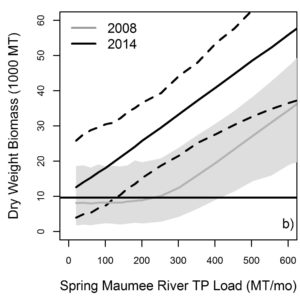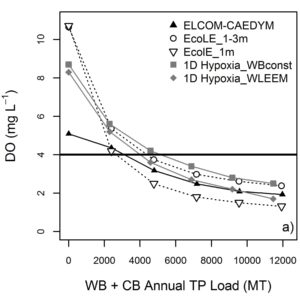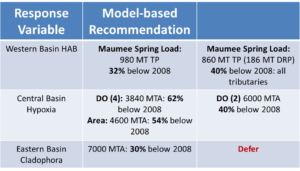Lake Erie & the Great Lakes Water Quality Agreement
Following recommendations of the International Joint Commission’s Lake Erie Ecosystem
 Priority report and with urging from the Great Lakes states and provinces, The US and Canada renegotiated the Great Lakes Water Quality Agreement and charged a binational committee under the USEPA and Environment Canada with reviewing and recommending phosphorus loading target for Lake Erie to:
Priority report and with urging from the Great Lakes states and provinces, The US and Canada renegotiated the Great Lakes Water Quality Agreement and charged a binational committee under the USEPA and Environment Canada with reviewing and recommending phosphorus loading target for Lake Erie to:
- minimize hypoxic zones related to excessive phosphorus loading
- prevent nuisance levels of algal biomass

- maintain healthy nearshore ecosystems as indicated by algal communities
- prevent harmful algal blooms that produce toxins posing a human or ecosystem health threat
- ensure the open waters of the Western and Central Basins of Lake Erie maintain mesotrophic conditions and oligotrophic conditions are maintained in the Eastern Basin of Lake Erie
In support of that effort, we coordinated a multi-modeling approach that developed a series of phosphorus load-response curves for Lake Erie relating phosphorus loads to those objectives, resulting in a final report that helped guide recommendations that were eventually adopted by the United States and Canada:

Our contributions to this work have been published in the Journal of Great Lakes Research:
Scavia, D., J.V. DePinto, I. Bertani. 2016. A Multi-model approach to evaluating target phosphorus loads for Lake Erie. J. Great Lakes Res.
Bertani, I, D.R. Obenour, C. E. Steger, C. A. Stow, A. D. Gronewold, D. Scavia 2016 Probabilistically assessing the role of nutrient loading in harmful algal bloom formation in western Lake Erie. J Great Lakes. Res.
Bocaniov, S. and D. Scavia 2016 Temporal and spatial dynamics of large lake hypoxia: Integrating statistical and three-dimensional dynamic models to enhance lake management criteria. Water Resources Res. (Supplemental Information)
Bocaniov, S.A, L.F. Keon, Y.R. Rao, D.J. Schwab, D. Scavia. 2016 Simulating the effect of nutrient reduction on hypoxia in a large lake (Lake Erie, USA-Canada) with a three-dimensional lake model. J. Great Lakes. Res http://dx.doi.org/10.1016/j.jglr.2016.06.001
Rucinski, D., DePinto, J., Beletsky, D., Scavia, D. 2016 Modeling hypoxia in the Central Basin of Lake Erie under potential phosphorus load reduction scenarios. J. Great. Lakes Res.
Zhang, H., L. Boegman, D. Scavia, D. A. Culver. 2016. Spatial distributions of external and internal phosphorus loads in Lake Erie and their impacts on phytoplankton and water quality. J Great Lakes Res.